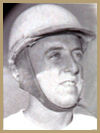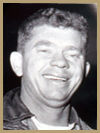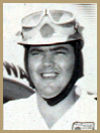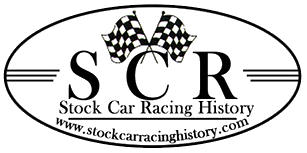Despite accruing the knowledge of what it took to win NASCAR Winston Cup races, the period was interesting in that both engine and body configurations went through several "generations" and radical changes as race cars, by and large, matched what was pushed in the showrooms by the manufacturers.
 |
| REX WHITE |
One of the most interesting occurrences in 1959 came when the Ford Motor Company abandoned its "top of the line" Galaxy model to use its Thunderbird as the race car of choice. The Galaxy was a fairly bulky car that year, so Holman & Moody, Ford's acknowledged racing arm, built a "fleet" of T-Birds to compete in NASCAR Winston Cup racing. The T-Bird was lower and sleeker than the Galaxy but it still fell within the dimensional parameters set in the NASCAR rules...even though the car had been created as a "sports car" that was designed to compete with Chevrolet's Corvette.
Although the T-Bird continued to compete, Ford returned to its "premier" Galaxy Starliner model in 1960.
Conventional, full frame cars were still the norm as purpose-built tube frame race cars were still out on the horizon in NASCAR Winston Cup racing. Stories of race teams -- as Ray Fox's did in 1960 to win the Daytona 500 -- picking up cars from showrooms only days before races and converting them to race cars were commonplace.
In the General Motors' camp, teams had figured out the coil spring rear suspension set-up that was introduced in 1958 and virtually everyone was running the 1959 Chevrolet on the big tracks, where it was particularly effective. This "light bulb" effect certainly led some to believe that the racers must have gotten some suspension geometry help from Detroit, but the manufacturers were still laying pretty low due to the Automobile Manufacturers Association (AMA) agreement that had disassociated them from the sport.
Through this period, of course, innovation often was the answer to necessity, and with many NASCAR races still conducted on dirt tracks and with pavement tracks sometimes coming apart, screens, grillwork and other protective devices were often de rigeur.
The early days found race teams not necessarily locked-into a particular manufacturer's model or even make. They were able to do some amazing things with cars that looked particularly unwieldy to the naked eye: Witness the monstrous Oldsmobile with which Lee Petty won the inaugural Daytona 500, which was a somewhat tank-like ride. Petty jumped back and forth between Chrysler and Oldsmobile in that time, depending on which car was more suited to the task at hand.
 |
| JOE WEATHERLY |
As the "superspeedway boom" era continued, manufacturers began to pay more attention to aerodynamics. The 1963 Ford Fastback Galaxy was used in the manufacturer's literature and was advertised as a race car. The 1960-61 Starliner had what was actually an effectively aerodynamic roofline. In fact, with the 1962 car a pretty boxy proposition, Fred Lorenzen ran a 1962 Galaxy with a 1961 Ford roof in a one-shot deal for the PRIMESTAR 500 -- and won the race in the car's only appearance.
General Motors had a grip on the NASCAR Winston Cup championship in the early 1960s, with Rex White and Ned Jarrett winning titles in 1960-1961 in Chevrolets and Joe Weatherly copping the titles in 1962-1963 -- primarily in Pontiacs. In the 1961-1962 season Pontiac won more races than any manufacturer in the history of the NASCAR Winston Cup Series in consecutive years: 52.
Mercury added a twist to the manufacturers' battle when it entered racing in a bigger way in 1963 with its Marauder model. Bill Stroppe, the West Coast's answer to Holman & Moody, handled the Mercury competition program with a similar assembly line approach. Unknown newcomer Billy Wade swept four straight races in 1964 driving a Mercury.
Mercury prompted the switch of legendary NASCAR car owner Bud Moore to the Ford Motor Co. camp when Moore -- in the absence of significant support from General Motors -- switched from Pontiac to Mercury. Weatherly took the 1963 championship but had to pick-up rides for most of the year. Ford scored another coup when it grabbed Fireball Roberts, who won his first race for Ford in 1963 at Bristol (Tenn.) Motor Speedway. The swapping of personnel is one part of stock car evolution that has been around since the beginning.
Shock development, which today is acknowledged as critical to race car performance, also experienced more emphasis in the early 1960s. The popular "Air Lift" shocks were being phased out and Monroe and Gabriel became heavily involved in shock development for racing applications.
Tire development also continued. Firestone was the dominant tire company, but Goodyear was involved to a limited degree. Increasing speeds made these developments important.
The end of this period also brought an end to one unique item. Through the early 1960s, Lorenzen still used a trap door in the driver's compartment to check tire wear. By 1965, however, nobody used the device that was once a favorite of dirt track competitors.
Another significant advance during this period occurred as roll cage structures began to become a more integral part of the car and as such, were used to stiffen the chassis and improve a car's handling as well as serving as vital protection.
A variety of triangulated bars, from front to back, across the mid-section of the car and also used as door bars were as much to stiffen and strengthen the cars as they were to serve as protection. There was a tremendous amount of flex inherent in the "x-frame" cars used in the 1958-60 period. Yunick was one of the first car builders to use the roll cage as an integral part of the car's chassis.
Ford had unleashed the flow of relatively open factory support when it repudiated the AMA agreement in 1962. While General Motors remained mostly silent, within a few weeks Chrysler announced it would develop "high performance" parts for stock car racing.
Another big issue of this period was in the engine compartment.
Noted mechanic Ray Fox was the mastermind behind Chevrolet's so-called "mystery engine," a 427 cubic inch "high lift" high performance piece that would replace the 409 cubic inch engine that was often referred to as a "boat anchor" because of its weight. Smokey Yunick, the other of the legendary mechanical pair who lived in Daytona Beach, Fla., was also involved in the development of that engine.
 |
| JUNIOR JOHNSON |
While much of the mystique of this engine was as much hype as it was fact, at the time Ford claimed it spent $1 million chasing the development curve on Chevy's powerplant. Junior Johnson, driving Fox's 1963 Chevrolet, sat on a lot of front rows with the combination, but as had often been the case with other potent mixes, in most cases the car was either a top-five finisher or it broke. Among the team's accomplishments in 1963 was sweeping the front row for the Firecracker 400 at Daytona International Speedway, with Johnson and G.C. Spencer doing the honors.
The "engine wars" reached a peak when in 1964 Richard Petty brought a Plymouth hemispherical combustion chamber engine, or "hemi," and cleaned house at Daytona, including winning the first of seven Daytona 500s. The Plymouth and Dodge body styles had been streamlined somewhat first. The hemis: Plymouth's "Super-Commando" and Dodge's "Hemi- Charger," now had an appropriate platform in which to sit.
The engine had first been produced in the early 1950s, but had been shelved with the AMA ban in 1956. Chrysler engineers also came up with a double rocker arm system used in conjunction with the hemi heads. This combination, which created a free-breathing combustion chamber, produced a good bit of top end horsepower, particularly on high speed facilities.
Ford came back with its "tunnel port" 427 cubic inch engine. And Ford had a very well- handling race car. Following the Daytona 500, the fourth point race of the season, Ford won 11 out of the next 15 races -- 13 of which were on short tracks. Plymouth and Dodge won two race apiece in that stretch.
As was the case in many other aspects of racing, NASCAR kept a close eye on these developments and took action as it became necessary. The repercussions from that highlighted the next period in the evolution of a stock car.

Copyright © 1999 NASCAR and/or Starwave Corporation and ESPN Inc. All rights reserved. Do not duplicate or redistribute in any form.


